National Art Museum of Azerbaijan
| Azərbaycan Milli İncəsənət Muzeyi | |
_edited.jpg) Palace of De Boure - first building of the National Art Museum of Azerbaijan | |
| Established | 1936 |
|---|---|
| Location |
Niyazi Street 9/11, Baku, Azerbaijan |
| Type | Art museum |
| Collection size | 15,000 items: 3,000 items displayed (12,000 items stored) |
| Public transit access | M 1 Icheri Sheher metro station |
| Website | Nationalmuseum.az |
National Art Museum of Azerbaijan (Azerbaijani: Azərbaycan Milli İncəsənət Muzeyi) is the biggest art museum of Azerbaijan.[1] It was founded in 1936 in Baku and in 1943 was named after Rustam Mustafayev,[1] a prominent Azerbaijani scenic designer and theater artist. The museum consists of two buildings standing next to each other. The museum's total collection includes over 15,000 artworks. There are over 3,000 items in 60 rooms on permanent display. About 12,000 items are kept in storage. The museum changes the exhibits periodically so that more of these artworks can be displayed temporarily.[2]
History
In 1936, the Council of People's Commissars of Azerbaijan SSR decided to separate the Art department from the Azerbaijan State Museum and organized it as an independent museum. Expeditions provided the museum with the first exhibits. In addition, other exhibits were purchased. The opening ceremony of the museum’s first exhibition was organized in 1937 and in 1951, the building of the museum was replaced with the Baroque-style De Bour mansion built at the end of the 19th century.
In 2006, the building was thoroughly reconstructed and the opening of a new exhibition took place in 2009. In 2011, the museum was declared to be of first National and then European Museum Standard (EUMS), meeting international standards and criteria, as appropriate for a museum and implying high quality museum services and professional experience; this was by unanimous decision of the Council of Directors of the European Economic Chamber of Trade, Commerce and Industry – EEIG - located in Brussels.
There are approximately 9,000 scientific books and monographs, catalogues, albums and other professional literature in the library of the museum. There is also a rare books collection of old publications.
Exhibits preserved in the collection of Azerbaijan National Art Museum include antique works of art that date from the 4th century BC. Ceramic bowls decorated with archaic ornamentation found in Nakhchivan, Mingachevir, Füzuli and Khanlar (now Goy-gol); decorative lamps and glazed tiles of the Seljuq period; parts of the friezes from the 13th century Bayil castle; 14th-18th century chests found in Absheron and Shamakhi; fine manuscripts about the Qur’an and 16th century books about astrology; original 17th-18th century Tabriz miniatures in tempera, gold water and watercolor; works by the celebrated artists Mir Mohsun Navvab, Mirza Qadim Irevani, Usta Qambar Qarabaghini, by the first professional artists in Azerbaijan and by our contemporaries; artistic metal items from the 16th and 17th centuries and samples of original fabric, embroidery, national costume and carpets and jewellery from the 18th-20th centuries are preserved here.[3] Moreover, the collection of the national treasures, the examples of statuary, fine and graphic arts and other decorative-applied arts of Western Europe (France, Germany, Austria, Italy, Greece, Flanders, Denmark, Spain), the East (Iran, Turkey, Japan, China, India, Egypt, Middle East) and Russia is available at the museum.
Along with the carpets, other types of Azerbaijan decorative and applied arts, such as different techniques of embroidery, artistic metalwork, artistic fabrics, carving in wood, jewellery making, etc. are exhibited here. The gold thread embroidery of "gulabatin" type is widely spread throughout Azerbaijan. Shamakhi, Shusha, and Baku have traditionally been centers for this kind of art. Red and green velvet used to be the base for the gold and silver thread embroidery. Hats and so-called "arakhchins" were ornamented with rosettes and medallions made from stylized petals and stars. The "arkhalig" and "kulaja" also used to be embroidered with gold threads. The objects of different shape, size and purpose embroidered with gold threads including "arakhchins", kerchiefs, shoes, etuis for combs and cosmetics, dyes for eyebrows and eyelashes, etuis for watches, pencil-boxes, and many other things are displayed at the museum.
The displays
Seven of the rooms in the first building feature European art, and ten rooms feature Russian art. European art includes works of Italian (Guercino, Leandro Bassano, Francesco Solimena, Lorenzo Bartolini), French (Jules Dupré, Gaspard Dughet, Pascal Dagnan-Bouveret, Jean-Joseph Benjamin-Constant), Dutch/Flemish (Frans Hals, Michiel Jansz van Mierevelt, Adriaen Brouwer, Adriaen van Ostade, Justus Sustermans, Pieter Claesz), German (Johann Heinrich Roos, Friedrich August von Kaulbach) and Polish (Jan Styka) painters.
The second edifice built in 1885 houses Eastern art, represented particularly by Persian, Turkish, Chinese and Japanese art. Russian art is encompassed notably by paintings of Karl Briullov, Alexey Venetsianov, Vasily Vereshchagin, Isaac Levitan, Vladimir Makovsky, Valentin Serov, Vladimir Borovikovsky, Vasily Tropinin, Konstantin Korovin and Ivan Shishkin. There are also restored samples of Russian avant-garde.
Among Azerbaijani artists represented are painters Mir Mohsun Navvab, Bahruz Kangarli, Tair Salakhov, Azim Azimzade, Salam Salamzade, Vidadi Narimanbekov, Mikail Abdullayev, Togrul Narimanbekov and sculptor Omar Eldarov. The works of Sattar Bahlulzade fill one entire room.
The museum also holds easel and book miniatures of 17th-19th centuries, lacquered miniatures of 18th-19th centuries and collection of sherbet spoons, made from mulberry tree.
The first works were obtained from Saint-Petersburg, Moscow and private collections. The museum expositions were later exhibited in Canada (1966), Cuba (1967), Syria (1968), France (1969), former Czechoslovakia, Algeria (both 1970), Iraq (1971) etc.[1]
- Opening times
The museum is open from 10 a.m. to 6 p.m.[4] Monday is the day off of the museum.
- Address
National Art Museum of Azerbaijan is located on Niyazi str. 11-13, Baku 1001 (near Icherisheher metro station).[5]
Gallery
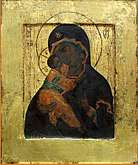 Theotokos of Vladimir, late 16th century
Theotokos of Vladimir, late 16th century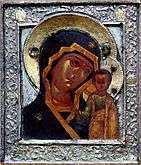 Our Lady of Kazan, late 17th century
Our Lady of Kazan, late 17th century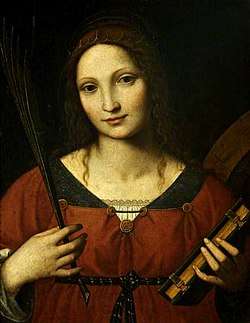 Bernardino Luini - St. Catherine, 16th century
Bernardino Luini - St. Catherine, 16th century Andrea del Sarto - Madonna of the Harpies, 1517-1519
Andrea del Sarto - Madonna of the Harpies, 1517-1519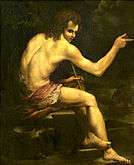 Bartolomeo Schedoni - John the Baptist, 17th century
Bartolomeo Schedoni - John the Baptist, 17th century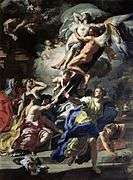 Francesco Solimena - Boreas Abducting Oreithyia, Daughter of Erechteus, 1729
Francesco Solimena - Boreas Abducting Oreithyia, Daughter of Erechteus, 1729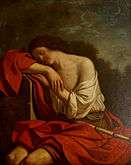 Guercino - Sleeping Endymion, 17th century
Guercino - Sleeping Endymion, 17th century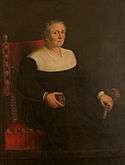 Leandro Bassano - Portrait of an Old Woman
Leandro Bassano - Portrait of an Old Woman- Balthasar Beschey - Venera and Adonis
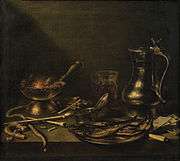 Pieter Claesz - Still life
Pieter Claesz - Still life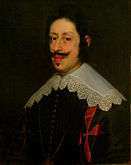 Justus Sustermans - Portrait of F. Medici, 17th century
Justus Sustermans - Portrait of F. Medici, 17th century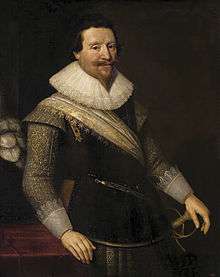 Michiel Jansz. van Mierevelt - Portrait of the Duke of Wallenstein, 17th century
Michiel Jansz. van Mierevelt - Portrait of the Duke of Wallenstein, 17th century- Frans Hals - Portrait of a man
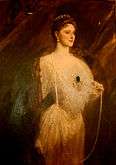 Jean-Joseph Benjamin-Constant - Portrait of the Empress Alexandra Fyodrovna, 19th century
Jean-Joseph Benjamin-Constant - Portrait of the Empress Alexandra Fyodrovna, 19th century Friedrich August von Kaulbach - Portrait of Grand Duchess Elisabeth Feodorovna, 19th century
Friedrich August von Kaulbach - Portrait of Grand Duchess Elisabeth Feodorovna, 19th century Jean-Baptiste Greuze - Portrait of a young woman, 18th century
Jean-Baptiste Greuze - Portrait of a young woman, 18th century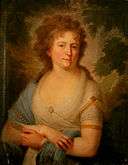 Eduard Joseph d'Alton - Portrait of a woman, 19th century
Eduard Joseph d'Alton - Portrait of a woman, 19th century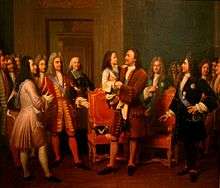
- Charles Le Brun - Banishment of Iliadore
 Adriaen Brouwer - Scene at a surgeon, 17th century
Adriaen Brouwer - Scene at a surgeon, 17th century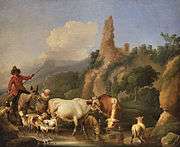 Johann Heinrich Roos - Herd, 1676
Johann Heinrich Roos - Herd, 1676- Louis Victor Watelin - Landscape, 1873
- Gaspard Dughet - Landscape
 Ivan Aivazovsky - The road in the woods, 1857
Ivan Aivazovsky - The road in the woods, 1857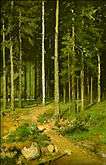 Ivan Shishkin - The road in the woods
Ivan Shishkin - The road in the woods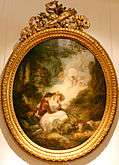 Jean-Honoré Fragonard - Pastorale
Jean-Honoré Fragonard - Pastorale Vasili Pukirev - Interrupted wedding
Vasili Pukirev - Interrupted wedding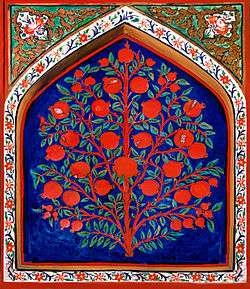
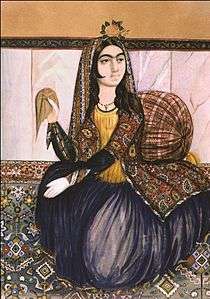 Mirza Kadym Irevani - Portrait of sitting woman, 1870
Mirza Kadym Irevani - Portrait of sitting woman, 1870 Ogtay Sadıgzadeh - Portrait of Khurshidbanu Natavan
Ogtay Sadıgzadeh - Portrait of Khurshidbanu Natavan
See also
References
- 1 2 3 Azerbaijan Soviet Encyclopedia. State Publishing House of the Council of Ministers of Azerbaijan SSR. 1976. pp. 1st vol, p. 144.
- ↑ "Breathing Life Back Into Art: The National Art Museum". Azer.com. Retrieved 2008-04-06.
- ↑ "The Azerbaijan National Art Museum". nationalmuseum.az. Retrieved 2017-05-18.
- ↑ "For the visitors". nationalmuseum.az. Retrieved 22 May 2017.
- ↑ "Contact". nationalmuseum.az (in Azerbaijani). Retrieved 22 May 2017.
External links
| Wikimedia Commons has media related to National Art Museum of Azerbaijan. |
- Official website (in English)
- Museum's overview (Bakupages.com)
Coordinates: 40°21′47″N 49°49′54″E / 40.36306°N 49.83167°E